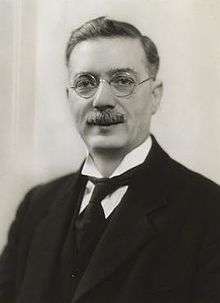George Spencer (Labour politician)
| George Alfred Spencer | |
|---|---|
 | |
| Member of Parliament for Broxtowe | |
|
In office 14 December 1918 – 30 May 1929 | |
| Preceded by | Constituency created |
| Succeeded by | Frederick Seymour Cocks |
| Personal details | |
| Born |
George Alfred Spencer 1873 |
| Died | 21 November 1957 |
| Political party |
Labour (Before 1926) Liberal (After 1926) |
George Alfred Spencer (1873 – 21 November 1957) was an English miner, trade union leader and Member of Parliament from 1918 to 1929 for Broxtowe.[1]
Family life
George Spencer was the second son of eighteen children. His youngest daughter was the wife of the director of the NSPCC in the 1930s.
Trade Union career
George Spencer was an official of the Nottinghamshire Miners Association, which was affiliated to the Miners Federation of Great Britain. In 1926, at the height of the General Strike, on behalf of the Nottinghamshire Miners Association he negotiated a deal with the local mine owners at the request of miners from Digby pit near Eastwood, Nottinghamshire in Nottinghamshire . However, this brought him into conflict with the MFGB who wished to see the strike continue. Unhappy with the influence of the MFGB, he led a breakaway from the NMA and set up the Nottinghamshire and District Miners' Industrial Union (NMIU) based mostly in The Dukeries, which lasted for eleven years separate from the Miners' Federation of Great Britain. In 1937, an agreement was reached between the NMA and the NMIU and they merged, with Spencer becoming the President of the merged organisation.[2]
Political career
During the Great War he combined with fellow Nottinghamshire Miners official and Liberal MP John Hancock to attempt to take the Nottinghamshire Miners Association out of the Miners Federation of Great Britain political fund, as he believed in trade union independence from party political control.[3] He was elected to parliament in 1918 as Labour MP for Broxtowe, and re-elected at the next three general elections. Following the Nottinghamshire miners union split of 1926, he was expelled from the Labour party. He continued to sit in parliament until 1929, speaking from the Liberal party benches.[4][5] The Broxtowe Labour party, instead of replacing him with another local miners candidate, chose Seymour Cocks, an outsider with no mining background. He served as a councillor on Nottinghamshire County Council for Stapleford.
References
- ↑ https://www.theyworkforyou.com/mp/george_spencer/broxtowe
- ↑ http://www.nottinghamshireexminer.com/Nottinghamshire-NUM-Area-History
- ↑ Industrial Politics and the 1926 Mining Lockout
- ↑ The Fortnightly Review (1927)
- ↑ The Derbyshire miners:a study in industrial and social history (1962)
External links
- Hansard 1803–2005: contributions in Parliament by George Alfred Spencer
| Parliament of the United Kingdom | ||
|---|---|---|
| New constituency | Member of Parliament for Broxtowe 1918 – 1929 |
Succeeded by Seymour Cocks |
| Trade union offices | ||
| Preceded by John E. Whyatt |
President of the Nottinghamshire Miners' Association 1912–1918 |
Succeeded by Frank Varley |
| Preceded by William Carter |
General Secretary of the Nottinghamshire Miners' Association 1918–1926 |
Succeeded by Frank Varley |
| Preceded by Bernard Taylor |
President of the Nottinghamshire Miners' Association 1937–1945 |
Succeeded by Bill Bayliss |